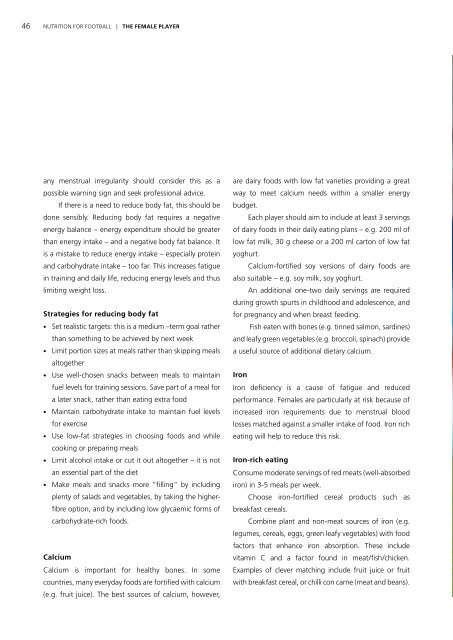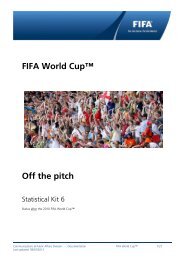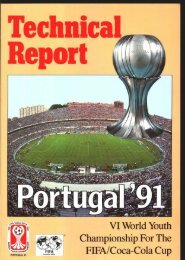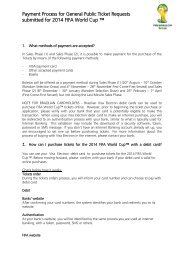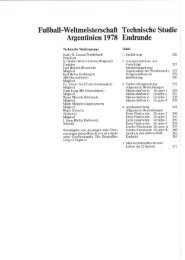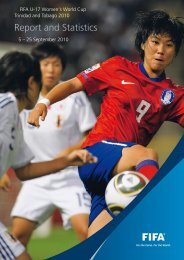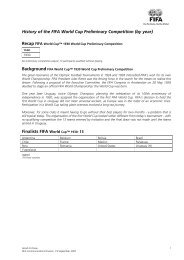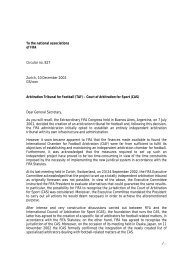Nutrition for football - FIFA.com
Nutrition for football - FIFA.com
Nutrition for football - FIFA.com
You also want an ePaper? Increase the reach of your titles
YUMPU automatically turns print PDFs into web optimized ePapers that Google loves.
46 NUTRITION FOR FOOTBALL | thE FEMalE PlayEr<br />
NUTRITION FOR FOOTBALL | thE FEMalE PlayEr 47<br />
any menstrual irregularity should consider this as a<br />
possible warning sign and seek professional advice.<br />
If there is a need to reduce body fat, this should be<br />
done sensibly. Reducing body fat requires a negative<br />
energy balance – energy expenditure should be greater<br />
than energy intake – and a negative body fat balance. It<br />
is a mistake to reduce energy intake – especially protein<br />
and carbohydrate intake – too far. This increases fatigue<br />
in training and daily life, reducing energy levels and thus<br />
limiting weight loss.<br />
Strategies <strong>for</strong> reducing body fat<br />
• Set realistic targets: this is a medium –term goal rather<br />
than something to be achieved by next week<br />
• Limit portion sizes at meals rather than skipping meals<br />
altogether<br />
• Use well-chosen snacks between meals to maintain<br />
fuel levels <strong>for</strong> training sessions. Save part of a meal <strong>for</strong><br />
a later snack, rather than eating extra food<br />
• Maintain carbohydrate intake to maintain fuel levels<br />
<strong>for</strong> exercise<br />
• Use low-fat strategies in choosing foods and while<br />
cooking or preparing meals<br />
• Limit alcohol intake or cut it out altogether – it is not<br />
an essential part of the diet<br />
• Make meals and snacks more “filling” by including<br />
plenty of salads and vegetables, by taking the higherfibre<br />
option, and by including low glycaemic <strong>for</strong>ms of<br />
carbohydrate-rich foods.<br />
calcium<br />
Calcium is important <strong>for</strong> healthy bones. In some<br />
countries, many everyday foods are <strong>for</strong>tified with calcium<br />
(e.g. fruit juice). The best sources of calcium, however,<br />
are dairy foods with low fat varieties providing a great<br />
way to meet calcium needs within a smaller energy<br />
budget.<br />
Each player should aim to include at least 3 servings<br />
of dairy foods in their daily eating plans – e.g. 200 ml of<br />
low fat milk, 30 g cheese or a 200 ml carton of low fat<br />
yoghurt.<br />
Calcium-<strong>for</strong>tified soy versions of dairy foods are<br />
also suitable – e.g. soy milk, soy yoghurt.<br />
An additional one-two daily servings are required<br />
during growth spurts in childhood and adolescence, and<br />
<strong>for</strong> pregnancy and when breast feeding.<br />
Fish eaten with bones (e.g. tinned salmon, sardines)<br />
and leafy green vegetables (e.g. broccoli, spinach) provide<br />
a useful source of additional dietary calcium.<br />
iron<br />
Iron deficiency is a cause of fatigue and reduced<br />
per<strong>for</strong>mance. Females are particularly at risk because of<br />
increased iron requirements due to menstrual blood<br />
losses matched against a smaller intake of food. Iron rich<br />
eating will help to reduce this risk.<br />
iron-rich eating<br />
Consume moderate servings of red meats (well-absorbed<br />
iron) in 3-5 meals per week.<br />
Choose iron-<strong>for</strong>tified cereal products such as<br />
breakfast cereals.<br />
Combine plant and non-meat sources of iron (e.g.<br />
legumes, cereals, eggs, green leafy vegetables) with food<br />
factors that enhance iron absorption. These include<br />
vitamin C and a factor found in meat/fish/chicken.<br />
Examples of clever matching include fruit juice or fruit<br />
with breakfast cereal, or chilli con carne (meat and beans).


